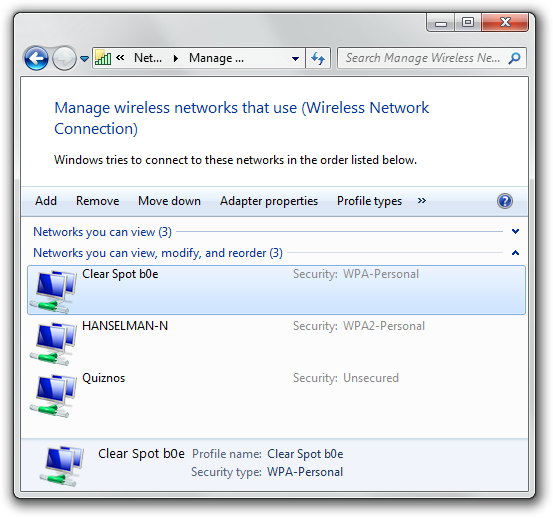Connection request was completed successfully.
More Details
What happened there? Well, the command line is netsh wlan and the full one is
netsh wlan connect ssid=YOURSSID name=PROFILENAME
What's a profile? It's the only thing required. You can see them with:
C:\>netsh wlan show profile
Profiles on interface Wireless Network Connection:
...snip..
User profiles
-------------
All User Profile : Clear Spot b0e
All User Profile : HANSELMAN-N
All User Profile : Quiznos
More Details
What happened there? Well, the command line is netsh wlan and the full one is
netsh wlan connect ssid=YOURSSID name=PROFILENAME
What's a profile? It's the only thing required. You can see them with:
C:\>netsh wlan show profile
Profiles on interface Wireless Network Connection:
...snip..
User profiles
-------------
All User Profile : Clear Spot b0e
All User Profile : HANSELMAN-N
All User Profile : Quiznos

You can set these up and refer to them by name from the command line, or a batch file, etc. Nice to do for the places you are regularly.
If you have multiple wireless cards (What's wrong with you!?) then you have to be more specific:
netsh wlan connect ssid=YOURSSID name=PROFILENAME interface="WIRELESS NETWORK CONNECTION"
And of course, you can
netsh wlan disconnect
And include the interface optionally, for multiple interfaces. Additionally, interesting things can be seen with
netsh wlan dump
This is nice because you can
netsh wlan dump > myconfig.txt
on one machine and then later on another machine
netsh exec myconfig.txt
All this command line love will work in most versions of Windows, actually, not just 7 AFAIK. There's lots of more detail and docs on managing Wireless Profiles on the Web.
Enjoy! (From Scott Hanselman Blog)




No comments:
Post a Comment